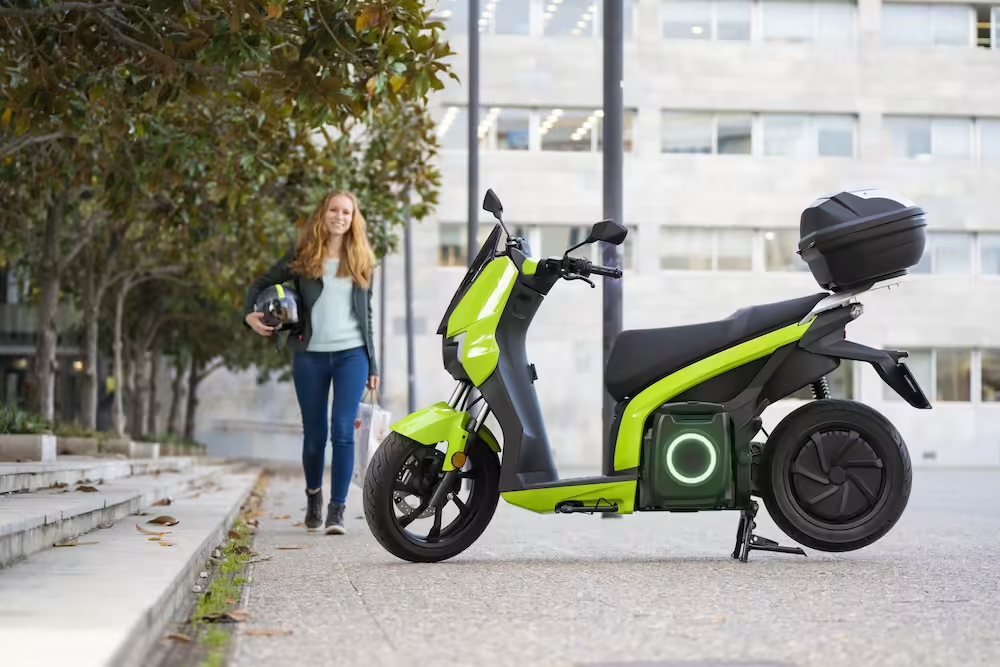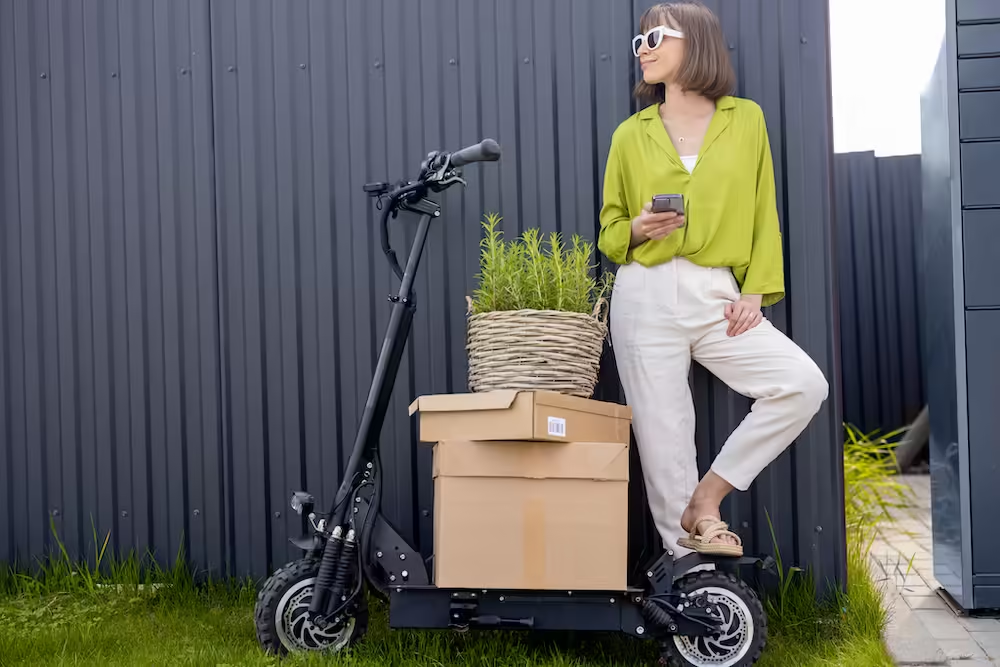
Electric scooters have become a popular mode of transport, offering a convenient, eco-friendly, and cost-effective way to navigate city streets. Whether you use your electric scooter for daily commuting or weekend joyrides, regular maintenance is essential to ensure optimal performance and longevity. This guide will cover everything you need to know about taking care of your electric scooter, from basic maintenance tips to handling battery care and storage.

1. Regular Cleaning: Keeping Your Scooter in Top Shape
One of the simplest ways to maintain your electric scooter is through regular cleaning. Dirt, dust, and grime can accumulate on your scooter, affecting its performance and aesthetics. Here’s how to clean your scooter properly:
- Wipe Down the Exterior: Use a damp cloth to clean the frame, deck, and handlebar. Avoid using a hose or high-pressure water jet, as excessive water can damage the electrical components.
- Clean the Wheels and Brakes: Dirt buildup on the wheels can affect traction and braking. Use a soft brush to remove debris from the tires and brake discs. If your scooter has drum or disc brakes, ensure they are free from oil or grease.
- Inspect for Rust: Regularly check for signs of rust on metal parts, especially if you ride in wet conditions. Apply a rust remover or anti-rust spray if necessary to prevent corrosion.
- Keep It Dry: After cleaning, ensure the scooter is completely dry before riding. Excess moisture can damage electrical components over time.
2. Battery Care: Maximizing Your Scooter’s Lifespan
The battery is the heart of your electric scooter, and proper care is crucial to maintain its performance and extend its life. Follow these battery care tips:
- Charge Regularly: Avoid letting the battery drain completely before charging. It’s best to recharge when it reaches around 20-30% to maintain optimal battery health.
- Use the Original Charger: Always use the charger that came with your scooter or a compatible one recommended by the manufacturer. Using the wrong charger can damage the battery and reduce its lifespan.
- Avoid Overcharging: Although many modern scooters have built-in protections against overcharging, it’s still good practice to unplug the charger once the battery is fully charged. Overcharging can cause overheating and degrade battery performance over time.
- Charge in Moderate Temperatures: Extreme temperatures can harm the battery. Charge your scooter in a cool, dry place, ideally between 50°F and 86°F (10°C to 30°C). Avoid charging in direct sunlight or freezing conditions.
- Storage During Inactivity: If you plan not to use your scooter for an extended period, charge the battery to around 50-60% and store it in a cool, dry place. Check the battery every month and recharge if it falls below 20%.

3. Tire Maintenance: Ensuring a Smooth Ride
Tire maintenance is essential for safety and ride quality. Here’s how to keep your tires in top condition:
- Check Tire Pressure: If your scooter has pneumatic (air-filled) tires, regularly check the tire pressure. Low pressure can affect handling and increase the risk of punctures. Inflate the tires according to the manufacturer’s recommended PSI.
- Inspect for Wear and Tear: Examine the tires for signs of wear, cracks, or damage. Replace tires that are excessively worn to maintain traction and safety.
- Avoid Sharp Objects: Be mindful of where you ride, as sharp objects like nails or glass can puncture your tires. If you frequently ride on rough terrain, consider upgrading to puncture-resistant tires.
- Rotate Tires if Possible: If your scooter’s tires show uneven wear, rotating them can extend their lifespan. Check the user manual to see if your scooter model allows tire rotation.
4. Brake Maintenance: Stopping Power Matters
Effective brakes are crucial for safe riding. Regularly inspect and maintain your scooter’s braking system:
- Check Brake Pads and Discs: Inspect the brake pads for wear and ensure the discs are free from debris or oil. Replace worn-out brake pads promptly to maintain stopping power.
- Adjust Brake Cables: Over time, brake cables can stretch, reducing braking efficiency. Adjust the brake cables as needed to ensure responsive braking.
- Lubricate Moving Parts: Keep brake levers and other moving parts well-lubricated to ensure smooth operation. Use a lubricant recommended for scooters or bicycles.
5. Regular Inspections: Staying Ahead of Issues
Performing regular inspections can help you catch small issues before they become significant problems. Here are some key areas to focus on:
- Inspect the Frame and Handlebar: Check for any cracks, dents, or loose bolts on the frame and handlebar. Tighten any loose screws or bolts to maintain structural integrity.
- Check the Suspension System: If your scooter has suspension, inspect it for signs of wear or damage. Properly functioning suspension is crucial for a smooth ride, especially on uneven terrain.
- Test Lights and Indicators: If your scooter is equipped with lights, horns, or turn indicators, regularly check that they are functioning correctly. Replace any faulty bulbs or components to ensure visibility and safety.
- Listen for Unusual Sounds: Unusual noises, such as squeaks or rattles, can indicate loose parts or mechanical issues. Investigate and resolve any abnormal sounds to prevent further damage.

6. Software Updates and Diagnostics: Keeping Your Scooter Smart
Many modern electric scooters come with onboard software that controls various aspects of their performance. Keeping this software updated is crucial:
- Check for Firmware Updates: Some scooters have apps that allow you to check for firmware updates. Regular updates can improve performance, fix bugs, and even extend battery life.
- Run Diagnostics: Use the scooter’s app or onboard diagnostics system to check for any errors or malfunctions. Address any detected issues promptly to maintain optimal performance.
7. Proper Storage: Protecting Your Scooter from the Elements
Proper storage is key to keeping your scooter in good condition, especially during bad weather or periods of inactivity:
- Store Indoors: Whenever possible, store your scooter indoors, away from rain, snow, and direct sunlight. Prolonged exposure to harsh weather can damage the battery, tires, and electronic components.
- Use a Cover: If indoor storage isn’t an option, use a waterproof cover to protect your scooter from the elements. A good cover will shield your scooter from dust, moisture, and UV rays.
- Lock It Up: Even when stored, secure your scooter with a lock to prevent theft. Choose a sturdy lock and attach it to a fixed object.

8. Know When to Seek Professional Help
While many maintenance tasks can be done at home, some repairs are best left to professionals:
- Battery Replacement: If your scooter’s battery performance declines significantly, consider professional replacement rather than attempting it yourself.
- Electrical Repairs: Issues with the motor, wiring, or other electrical components should be handled by a certified technician to avoid further damage or safety hazards.
- Suspension and Brake Overhauls: Complex components like suspension systems and hydraulic brakes may require specialized tools and expertise for repairs or replacements.
Conclusion: A Little Care Goes a Long Way
Taking good care of your electric scooter not only extends its life but also ensures a safer, more enjoyable riding experience. By following these maintenance tips—cleaning regularly, taking care of the battery, inspecting tires and brakes, and addressing issues promptly—you can keep your scooter in peak condition for years to come. Remember, proactive maintenance is always better than reactive repairs, and a well-maintained scooter will serve you reliably on every ride.

Leave a Reply